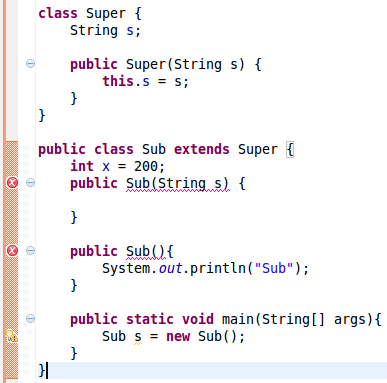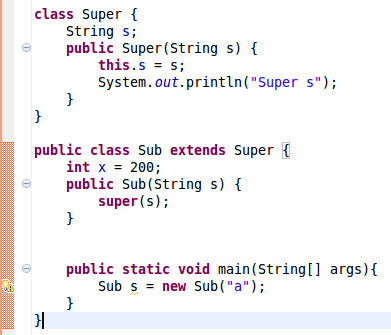This list summarizes the top 10 mistakes that Java developers frequently make.
#1. Convert Array to ArrayList
To convert an array to an ArrayList, developers often do this:
List<String> list = Arrays.asList(arr); |
Arrays.asList() will return an ArrayList which is a private static class inside Arrays, it is not the java.util.ArrayList class. The java.util.Arrays.ArrayList class has set(), get(), contains() methods, but does not have any methods for adding elements, so its size is fixed. To create a real ArrayList, you should do:
ArrayList<String> arrayList = new ArrayList<String>(Arrays.asList(arr)); |
The constructor of ArrayList can accept a Collection type, which is also a super type for java.util.Arrays.ArrayList.
#2. Check If an Array Contains a Value
Developers often do:
Set<String> set = new HashSet<String>(Arrays.asList(arr)); return set.contains(targetValue); |
The code works, but there is no need to convert a list to set first. Converting a list to a set requires extra time. It can as simple as:
Arrays.asList(arr).contains(targetValue); |
or
for(String s: arr){ if(s.equals(targetValue)) return true; } return false; |
The first one is more readable than the second one.
#3. Remove an Element from a List Inside a Loop
Consider the following code which removes elements during iteration:
ArrayList<String> list = new ArrayList<String>(Arrays.asList("a", "b", "c", "d")); for (int i = 0; i < list.size(); i++) { list.remove(i); } System.out.println(list); |
The output is:
[b, d]
There is a serious problem in this method. When an element is removed, the size of the list shrinks and the index changes. So if you want to delete multiple elements inside a loop by using the index, that will not work properly.
You may know that using iterator is the right way to delete elements inside loops, and you know foreach loop in Java works like an iterator, but actually it is not. Consider the following code:
ArrayList<String> list = new ArrayList<String>(Arrays.asList("a", "b", "c", "d")); for (String s : list) { if (s.equals("a")) list.remove(s); } |
It will throw out ConcurrentModificationException.
Instead the following is OK:
ArrayList<String> list = new ArrayList<String>(Arrays.asList("a", "b", "c", "d")); Iterator<String> iter = list.iterator(); while (iter.hasNext()) { String s = iter.next(); if (s.equals("a")) { iter.remove(); } } |
.next() must be called before .remove(). In the foreach loop, compiler will make the .next() called after the operation of removing element, which caused the ConcurrentModificationException. You may want to take a look at the source code of ArrayList.iterator().
#4. Hashtable vs HashMap
By conventions in algorithm, Hashtable is the name of the data structure. But in Java, the data structure’s name is HashMap. One of the key differences between Hashtable and HashMap is that Hashtable is synchronized. So very often you don’t need Hashtable, instead HashMap should be used.
HashMap vs. TreeMap vs. Hashtable vs. LinkedHashMap
Top 10 questions about Map
#5. Use Raw Type of Collection
In Java, raw type and unbounded wildcard type are easy to mixed together. Take Set for example, Set is raw type, while Set<?> is unbounded wildcard type.
Consider the following code which uses a raw type List as a parameter:
public static void add(List list, Object o){ list.add(o); } public static void main(String[] args){ List<String> list = new ArrayList<String>(); add(list, 10); String s = list.get(0); } |
This code will throw an exception:
Exception in thread "main" java.lang.ClassCastException: java.lang.Integer cannot be cast to java.lang.String at ...
Using raw type collection is dangerous as the raw type collections skip the generic type checking and not safe. There are huge differences between Set, Set<?>, and Set<Object>. Check out
Raw type vs. Unbounded wildcard and Type Erasure.
#6. Access Level
Very often developers use public for class field. It is easy to get the field value by directly referencing, but this is a very bad design. The rule of thumb is giving access level for members as low as possible.
public, default, protected, and private
#7. ArrayList vs. LinkedList
When developers do not know the difference between ArrayList and LinkedList, they often use ArrayList, because it looks familiar. However, there is a huge performance difference between them. In brief, LinkedList should be preferred if there are a large number of add/remove operations and there are not a lot of random access operations. Check out ArrayList vs. LinkedList to get more information about their performance if this is new to you.
#8. Mutable vs. Immutable
Immutable objects have many advantages such simplicity, safety, etc. But it requires a separate object for each distinct value, and too many objects might cause high cost of garbage collection. There should be a balance when choosing between mutable and immutable.
In general, mutable objects are used to avoid producing too many intermediate objects. One classic example is concatenating a large number of strings. If you use an immutable string, you would produce a lot of objects that are eligible for garbage collection immediately. This wastes time and energy on the CPU, using a mutable object the right solution (e.g. StringBuilder).
String result=""; for(String s: arr){ result = result + s; } |
There are other situations when mutable objects are desirable. For example passing mutable objects into methods lets you collect multiple results without jumping through too many syntactic hoops. Another example is sorting and filtering: of course, you could make a method that takes the original collection, and returns a sorted one, but that would become extremely wasteful for larger collections. (From dasblinkenlight’s answer on Stack Overflow)
#9. Constructor of Super and Sub

This compilation error occurs because the default super constructor is undefined. In Java, if a class does not define a constructor, compiler will insert a default no-argument constructor for the class by default. If a constructor is defined in Super class, in this case Super(String s), compiler will not insert the default no-argument constructor. This is the situation for the Super class above.
The constructors of the Sub class, either with-argument or no-argument, will call the no-argument Super constructor. Since compiler tries to insert super() to the 2 constructors in the Sub class, but the Super’s default constructor is not defined, compiler reports the error message.
To fix this problem, simply 1) add a Super() constructor to the Super class like
public Super(){ System.out.println("Super"); } |
, or 2) remove the self-defined Super constructor, or 3) add super(value) to sub constructors.
#10. “” or Constructor?
String can be created by two ways:
//1. use double quotes String x = "abc"; //2. use constructor String y = new String("abc"); |
What is the difference?
The following examples can provide a quick answer:
String a = "abcd"; String b = "abcd"; System.out.println(a == b); // True System.out.println(a.equals(b)); // True String c = new String("abcd"); String d = new String("abcd"); System.out.println(c == d); // False System.out.println(c.equals(d)); // True |
For more details about how they are allocated in memory, check out Create Java String Using ††or Constructor?.
Future Work
The list is based on my analysis of a large number of open source projects on GitHub, Stack Overflow questions, and popular Google queries. There is no evaluation to prove that they are precisely the top 10, but definitely they are very common. Please leave your comment, if you don’t agree with any part. I would really appreciate it if you could point out some other mistakes that are more common.

Very informative article, Thanks for sharing….
true
I don’t care if it’s top 10 or not.
What is more important that I found this article very useful.
Thanks a lot!
Thanks for the article from me as well.
A short question: Since which Java Version is the Syntax
ArrayList arrayList = new ArrayList(Arrays.asList(arr));
allowed?
Best Regards!
Top 10? Really? Where’s your data?
No question, many of these are valid points, but to say these are the top 10 mistakes is a tiny bit hyperbolic…
thx,useful article
Like this kind of stuff. Good everyday information.
it should be for (int i = list.size()-1; i >=0 0; i–)
#1. convert array into list
Using Arrays.asList method totally depends on the situation.
If I’m just converting the list for iteration purpose or to check its contents (no adding or removing is required), then the correct way to use is simply by the following code which is better in performance (not creating an extra unnecessary ArrayList in the middle and also eliminating the extra processing required to copy the contents from the fixed List to the new ArrayList):
List list = Arrays.asList(arr);
If I’m to alter its contents, then yes, the following code should be used and the above code is wrong:
ArrayList arrayList = new ArrayList(Arrays.asList(arr));
In fact, I haven’t closely read through all of the items, and jumped to conclusions. Sorry about that.
It works because the index is not affected. Thanks for pointing it out!
Can you show me an example which you have seen near top 10? That would be very interesting.
#3. Remove an Element from a List Inside a Loop
Have you simply considered this?
ArrayList list = new ArrayList(Arrays.asList(“a”, “b”, “c”, “d”));
for (int i = list.size(); i > 0; i–) {
list.remove(i);
}
System.out.println(list);
I sincerely doubt that this is anywhere near the top 10 mistakes that Java developers make… 😉 Unless…
… unless you could show some examples? Would be really curious about seeing who’s “doing it wrong”
useful article, thank you.